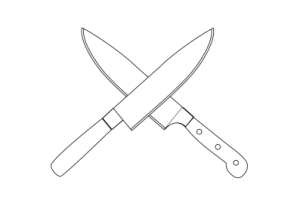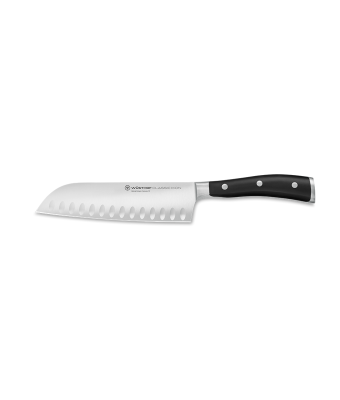Four Essential Knives

Knives are a very personal thing, and making sure you get the right one is very important.
After all they are a dangerous instrument so you need to make sure that you are comfortable and happy using the ones you choose.
A good place to start is to look at our 'must have' knives. These are the ones that we tend to use time and time again, and hopefully will give some useful guidance.
- Paring knife
- Cooks (or chefs) knife
- Bread (serrated) knife
- Santoku knife with fluted edge
This list is by no means exhaustive and of course there are many other useful knives that we will cover in another post.
In this guide:
- Intro
- Paring Knife
- Cook's Knife
- Bread Knife
- Santoku
Paring Knife
This is a very useful knife that you will find yourself using daily. Use it for delicate preparation work such as deseeding chillies, peppers & tomatoes, de-veining prawns, French trimming a bone, peeling, trimming and coring.
Paring knives usually have a blade length of 8-10cm and a thinner handle.
Cooks or Chefs Knife
This is the single most useful knife, and one that every kitchen should have – it is quite often referred to as a ‘manual food-processor’.
Its shape lends itself to many tasks from chopping, slicing & dicing to crushing & mincing garlic and herbs & spices.
The curve to the blade allows a rocking action on the board giving a more accurate cut.
There is a very wide spectrum of blade lengths going from 12cm up to a massive 35cm, though a generally more usable blade length would be 16-20cm.
Our advice is to get the knife with the longest possible blade length that you are comfortable holding, this will allow you to be more efficient and quicker especially when slicing larger items.
Bread Knife
A good quality serrated knife is by no means restricted to just cutting bread. Anything that has a crusty outer layer and a soft inner should be cut with this type of knife, think pies, quiches, pastries, cakes and breads.
By using a very sharp serrated (or scalloped) knife you will be to cut through the tough outer without crumbing and the soft inner without squashing.
Santoku Knife
The Santoku knife is the Far Eastern equivalent of a Western style cooks or chefs knife, and is used in a similar way.
Santoku translates literally as ‘three virtues’, or ‘three benefits’ – slicing, dicing and mincing. The shape of the blade make these knives ideal for the fast and accurate chopping of fruits and vegetables, the fluted edge (or pockets) on the blade give the added benefit of helping to stop foods sticking. This is particularly useful when either trying to cut very fine, thin cuts or chopping starchy foods such as potatoes.

